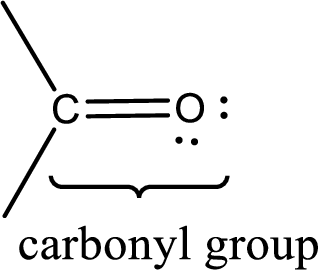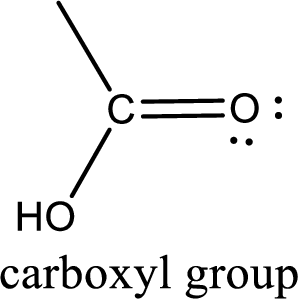
EBK ORGANIC AND BIOLOGICAL CHEMISTRY
7th Edition
ISBN: 9780100547742
Author: STOKER
Publisher: YUZU
expand_more
expand_more
format_list_bulleted
Concept explainers
Question
Chapter 5.1, Problem 2QQ
Interpretation Introduction
Interpretation:
Incorrect statement has to be chosen considering the
Concept Introduction:
Carbonyl groups are the one which contain a double bond between carbon and oxygen atom.

If a hydroxyl group is attached to a carbonyl group means it is known as carboxyl group. This can be represented as shown below,

Expert Solution & Answer
Trending nowThis is a popular solution!

Students have asked these similar questions
Identify the mechanism through which the following reaction will proceed and draw the major product.
Part 1 of 2
Br
KOH
EtOH
Through which mechanism will the reaction proceed? Select the single best answer.
E1
E2
neither
Part: 1/2
Part 2 of 2
Draw the major product formed as a result of the reaction.
Click and drag to start drawing a
structure.
X
What is single-point calibration? Provide an example.
Draw the major product formed via an E1 pathway.
Chapter 5 Solutions
EBK ORGANIC AND BIOLOGICAL CHEMISTRY
Ch. 5.1 - Prob. 1QQCh. 5.1 - Prob. 2QQCh. 5.1 - Prob. 3QQCh. 5.1 - Prob. 4QQCh. 5.1 - Prob. 5QQCh. 5.2 - Prob. 1QQCh. 5.2 - Prob. 2QQCh. 5.2 - Prob. 3QQCh. 5.2 - Prob. 4QQCh. 5.2 - Prob. 5QQ
Ch. 5.3 - Prob. 1QQCh. 5.3 - Prob. 2QQCh. 5.3 - Prob. 3QQCh. 5.4 - Prob. 1QQCh. 5.4 - Prob. 2QQCh. 5.4 - Prob. 3QQCh. 5.5 - Prob. 1QQCh. 5.5 - Prob. 2QQCh. 5.5 - Prob. 3QQCh. 5.6 - Prob. 1QQCh. 5.6 - Prob. 2QQCh. 5.7 - Which of the following statements about acid...Ch. 5.7 - Prob. 2QQCh. 5.7 - Prob. 3QQCh. 5.8 - Prob. 1QQCh. 5.8 - Prob. 2QQCh. 5.8 - Prob. 3QQCh. 5.8 - Prob. 4QQCh. 5.9 - Prob. 1QQCh. 5.9 - Prob. 2QQCh. 5.10 - Prob. 1QQCh. 5.10 - Prob. 2QQCh. 5.11 - Prob. 1QQCh. 5.11 - Prob. 2QQCh. 5.11 - Prob. 3QQCh. 5.12 - Prob. 1QQCh. 5.12 - Prob. 2QQCh. 5.12 - Prob. 3QQCh. 5.12 - Prob. 4QQCh. 5.13 - Prob. 1QQCh. 5.13 - Prob. 2QQCh. 5.14 - Prob. 1QQCh. 5.14 - Prob. 2QQCh. 5.14 - Prob. 3QQCh. 5.15 - Prob. 1QQCh. 5.15 - Prob. 2QQCh. 5.15 - Prob. 3QQCh. 5.16 - Prob. 1QQCh. 5.16 - Prob. 2QQCh. 5.16 - Prob. 3QQCh. 5.17 - Prob. 1QQCh. 5.17 - Prob. 2QQCh. 5.18 - Prob. 1QQCh. 5.18 - Prob. 2QQCh. 5.18 - Prob. 3QQCh. 5.19 - Prob. 1QQCh. 5.19 - Prob. 2QQCh. 5.19 - Prob. 3QQCh. 5.19 - Prob. 4QQCh. 5.20 - Prob. 1QQCh. 5.20 - Prob. 2QQCh. 5.20 - Prob. 3QQCh. 5.20 - Prob. 4QQCh. 5 - Prob. 5.1EPCh. 5 - Prob. 5.2EPCh. 5 - Prob. 5.3EPCh. 5 - Indicate whether or not each of the compounds in...Ch. 5 - Prob. 5.5EPCh. 5 - Prob. 5.6EPCh. 5 - Prob. 5.7EPCh. 5 - Prob. 5.8EPCh. 5 - Prob. 5.9EPCh. 5 - Prob. 5.10EPCh. 5 - Prob. 5.11EPCh. 5 - Prob. 5.12EPCh. 5 - Prob. 5.13EPCh. 5 - Prob. 5.14EPCh. 5 - Prob. 5.15EPCh. 5 - Assign an IUPAC name to each of the following...Ch. 5 - Prob. 5.17EPCh. 5 - Prob. 5.18EPCh. 5 - Prob. 5.19EPCh. 5 - Prob. 5.20EPCh. 5 - Prob. 5.21EPCh. 5 - Prob. 5.22EPCh. 5 - Prob. 5.23EPCh. 5 - Prob. 5.24EPCh. 5 - Prob. 5.25EPCh. 5 - Prob. 5.26EPCh. 5 - Prob. 5.27EPCh. 5 - Prob. 5.28EPCh. 5 - Prob. 5.29EPCh. 5 - Prob. 5.30EPCh. 5 - Prob. 5.31EPCh. 5 - Prob. 5.32EPCh. 5 - Prob. 5.33EPCh. 5 - Prob. 5.34EPCh. 5 - Prob. 5.35EPCh. 5 - Prob. 5.36EPCh. 5 - Prob. 5.37EPCh. 5 - Prob. 5.38EPCh. 5 - Prob. 5.39EPCh. 5 - Prob. 5.40EPCh. 5 - Determine the maximum number of hydrogen bonds...Ch. 5 - Prob. 5.42EPCh. 5 - Prob. 5.43EPCh. 5 - Prob. 5.44EPCh. 5 - Prob. 5.45EPCh. 5 - Prob. 5.46EPCh. 5 - Prob. 5.47EPCh. 5 - Prob. 5.48EPCh. 5 - Prob. 5.49EPCh. 5 - Prob. 5.50EPCh. 5 - Prob. 5.51EPCh. 5 - Prob. 5.52EPCh. 5 - Prob. 5.53EPCh. 5 - Prob. 5.54EPCh. 5 - Draw structural formulas for the following...Ch. 5 - Prob. 5.56EPCh. 5 - Give the IUPAC name for each of the following...Ch. 5 - Give the IUPAC name for each of the following...Ch. 5 - Prob. 5.59EPCh. 5 - Prob. 5.60EPCh. 5 - Prob. 5.61EPCh. 5 - Prob. 5.62EPCh. 5 - Prob. 5.63EPCh. 5 - Prob. 5.64EPCh. 5 - Prob. 5.65EPCh. 5 - Which three carboxylic acids have salts that are...Ch. 5 - Prob. 5.67EPCh. 5 - Which carboxylic acid has salts that are used to...Ch. 5 - Prob. 5.69EPCh. 5 - Prob. 5.70EPCh. 5 - Prob. 5.71EPCh. 5 - Prob. 5.72EPCh. 5 - Prob. 5.73EPCh. 5 - Prob. 5.74EPCh. 5 - Prob. 5.75EPCh. 5 - Prob. 5.76EPCh. 5 - Prob. 5.77EPCh. 5 - Prob. 5.78EPCh. 5 - Prob. 5.79EPCh. 5 - Prob. 5.80EPCh. 5 - Prob. 5.81EPCh. 5 - Prob. 5.82EPCh. 5 - Prob. 5.83EPCh. 5 - Prob. 5.84EPCh. 5 - Prob. 5.85EPCh. 5 - Prob. 5.86EPCh. 5 - Prob. 5.87EPCh. 5 - Prob. 5.88EPCh. 5 - Prob. 5.89EPCh. 5 - Prob. 5.90EPCh. 5 - Assign common names to each of the esters in...Ch. 5 - Prob. 5.92EPCh. 5 - Prob. 5.93EPCh. 5 - Assign an IUPAC name to each of the following...Ch. 5 - Draw a structural formula for each of the...Ch. 5 - Prob. 5.96EPCh. 5 - Prob. 5.97EPCh. 5 - Prob. 5.98EPCh. 5 - Prob. 5.99EPCh. 5 - Prob. 5.100EPCh. 5 - Prob. 5.101EPCh. 5 - How many carbon atoms are present in a molecule of...Ch. 5 - Prob. 5.103EPCh. 5 - Prob. 5.104EPCh. 5 - Prob. 5.105EPCh. 5 - Prob. 5.106EPCh. 5 - Prob. 5.107EPCh. 5 - Prob. 5.108EPCh. 5 - Prob. 5.109EPCh. 5 - Prob. 5.110EPCh. 5 - Prob. 5.111EPCh. 5 - Prob. 5.112EPCh. 5 - Prob. 5.113EPCh. 5 - Prob. 5.114EPCh. 5 - Prob. 5.115EPCh. 5 - Prob. 5.116EPCh. 5 - Prob. 5.117EPCh. 5 - Prob. 5.118EPCh. 5 - Prob. 5.119EPCh. 5 - Prob. 5.120EPCh. 5 - Prob. 5.121EPCh. 5 - Prob. 5.122EPCh. 5 - Prob. 5.123EPCh. 5 - Prob. 5.124EPCh. 5 - Write the structural formulas of the reaction...Ch. 5 - Prob. 5.126EPCh. 5 - Prob. 5.127EPCh. 5 - Prob. 5.128EPCh. 5 - Prob. 5.129EPCh. 5 - Prob. 5.130EPCh. 5 - Prob. 5.131EPCh. 5 - Prob. 5.132EPCh. 5 - Prob. 5.133EPCh. 5 - Prob. 5.134EPCh. 5 - Prob. 5.135EPCh. 5 - Prob. 5.136EPCh. 5 - Prob. 5.137EPCh. 5 - Prob. 5.138EPCh. 5 - Prob. 5.139EPCh. 5 - Prob. 5.140EPCh. 5 - Prob. 5.141EPCh. 5 - Prob. 5.142EPCh. 5 - Prob. 5.143EPCh. 5 - Prob. 5.144EPCh. 5 - Prob. 5.145EPCh. 5 - Prob. 5.146EPCh. 5 - Prob. 5.147EPCh. 5 - Prob. 5.148EPCh. 5 - Draw a condensed structural formula for the...Ch. 5 - Draw a condensed structural formula for the...Ch. 5 - Prob. 5.151EPCh. 5 - Prob. 5.152EPCh. 5 - Prob. 5.153EPCh. 5 - Prob. 5.154EPCh. 5 - Prob. 5.155EPCh. 5 - Prob. 5.156EPCh. 5 - Prob. 5.157EPCh. 5 - Prob. 5.158EPCh. 5 - Prob. 5.159EPCh. 5 - Prob. 5.160EPCh. 5 - Prob. 5.161EPCh. 5 - Prob. 5.162EPCh. 5 - Prob. 5.163EPCh. 5 - Prob. 5.164EP
Knowledge Booster
Learn more about
Need a deep-dive on the concept behind this application? Look no further. Learn more about this topic, chemistry and related others by exploring similar questions and additional content below.Similar questions
- Part 9 of 9 Consider the products for the reaction. Identify the major and minor products. HO Cl The E stereoisomer is the major product and the Z stereoisomer is the minor product ▼ S major product minor productarrow_forwardConsider the reactants below. Answer the following questions about the reaction mechanism and products. HO Clarrow_forwardjulietteyep@gmail.com X YSCU Grades for Juliette L Turner: Orc X 199 A ALEKS - Juliette Turner - Modul X A ALEKS - Juliette Turner - Modul x G butane newman projection - Gox + www-awa.aleks.com/alekscgi/x/Isl.exe/10_u-IgNslkr7j8P3jH-IBxzaplnN4HsoQggFsejpgqKoyrQrB2dKVAN-BcZvcye0LYa6eXZ8d4vVr8Nc1GZqko5mtw-d1MkNcNzzwZsLf2Tu9_V817y?10Bw7QYjlb il Scribbr citation APA SCU email Student Portal | Main Ryker-Learning WCU-PHARM D MySCU YSCU Canvas- SCU Module 4: Homework (Ch 9-10) Question 28 of 30 (1 point) | Question Attempt: 1 of Unlimited H₂SO heat OH The mechanism of this reaction involves two carbocation intermediates, A and B. Part 1 of 2 KHSO 4 rearrangement A heat B H₂O 2 OH Draw the structure of A. Check Search #t m Save For Later Juliet Submit Assignm 2025 McGraw Hill LLC. All Rights Reserved. Terms of Use | Privacy Center | Accessarrow_forward
- The electrons flow from the electron-rich atoms of the nucleophile to the electrons poor atoms of the alkyl halide. Identify the electron rich in the nucleophile. Enter the element symbol only, do not include any changes.arrow_forwardHello, I am doing a court case analysis in my Analytical Chemistry course. The case is about a dog napping and my role is prosecution of the defendant. I am tasked in the Area of Expertise in Neutron Activation and Isotopic Analysis. Attached is the following case study reading of my area of expertise! The landscaping stone was not particularly distinctive in its decoration but matched both the color and pattern of the Fluential’s landscaping stone as well as the stone in the back of the recovered vehicle. Further analysis of the stone was done using a technique called instrumental neutron activation analysis. (Proceed to Neutron Activation data) Photo Notes: Landscaping stone recovered in vehicle. Stone at Fluential’s home is similar inappearance. Finally, the white paint on the brick was analyzed using stable isotope analysis. The brick recovered at the scene had smeared white paint on it. A couple of pieces of brick in the back of the car had white paint on them. They…arrow_forwardCite the stability criteria of an enamine..arrow_forward
- What would you expect to be the major product obtained from the following reaction? Please explain what is happening here. Provide a detailed explanation and a drawing showing how the reaction occurs. The correct answer to this question is V.arrow_forwardPlease answer the question for the reactions, thank youarrow_forwardWhat is the product of the following reaction? Please include a detailed explanation of what is happening in this question. Include a drawing showing how the reagent is reacting with the catalyst to produce the correct product. The correct answer is IV.arrow_forward
arrow_back_ios
SEE MORE QUESTIONS
arrow_forward_ios
Recommended textbooks for you
 General, Organic, and Biological ChemistryChemistryISBN:9781285853918Author:H. Stephen StokerPublisher:Cengage Learning
General, Organic, and Biological ChemistryChemistryISBN:9781285853918Author:H. Stephen StokerPublisher:Cengage Learning Organic And Biological ChemistryChemistryISBN:9781305081079Author:STOKER, H. Stephen (howard Stephen)Publisher:Cengage Learning,
Organic And Biological ChemistryChemistryISBN:9781305081079Author:STOKER, H. Stephen (howard Stephen)Publisher:Cengage Learning,

General, Organic, and Biological Chemistry
Chemistry
ISBN:9781285853918
Author:H. Stephen Stoker
Publisher:Cengage Learning

Organic And Biological Chemistry
Chemistry
ISBN:9781305081079
Author:STOKER, H. Stephen (howard Stephen)
Publisher:Cengage Learning,